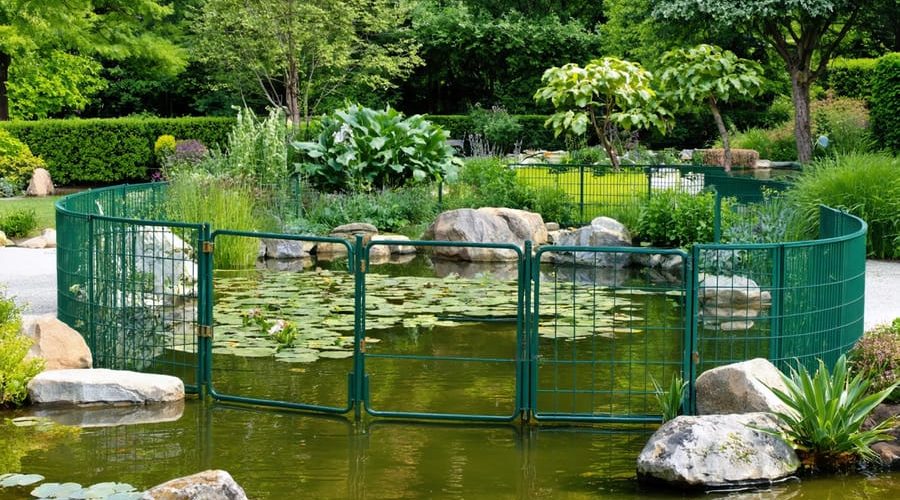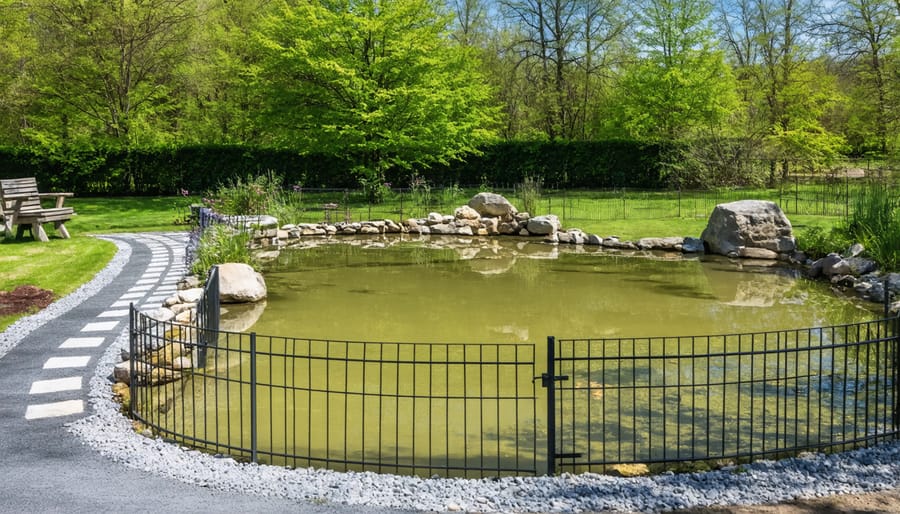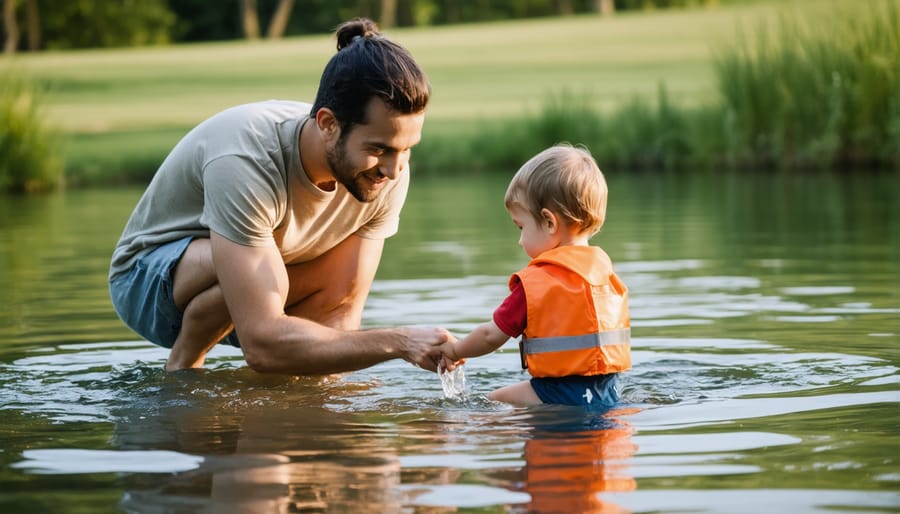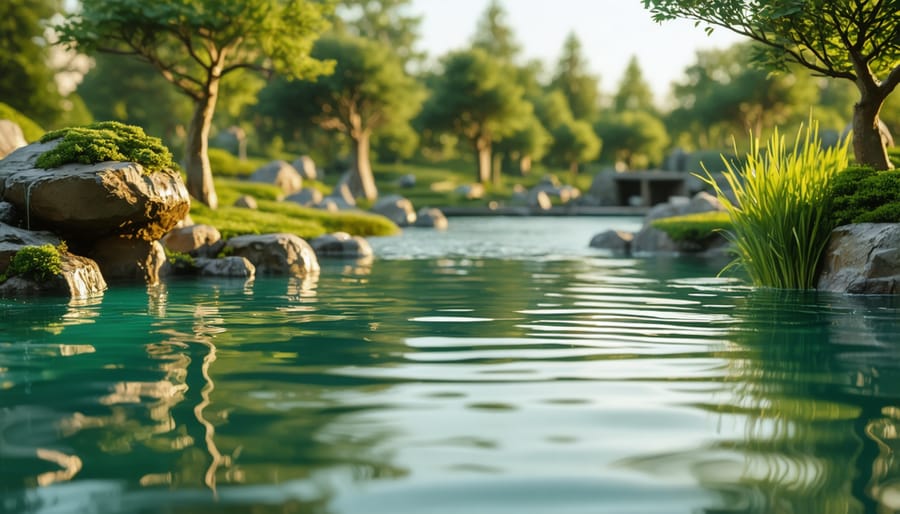
Keep Your Water Garden Safe: Essential Precautions Every Pond Owner Must Know
Water safety demands immediate attention and proper implementation to protect lives and create a secure environment around water features. Install physical barriers, including fencing at least 4 feet high with self-closing gates, around ponds and water gardens to prevent unauthorized access. Maintain crystal-clear water visibility through proper filtration and regular testing of chemical levels, enabling quick spotting of potential hazards or struggling swimmers. Establish designated safety zones with clearly marked depths, non-slip surfaces around water edges, and easily accessible rescue equipment including life rings and reaching poles.
Beyond physical safeguards, develop and communicate clear safety protocols for all family members and visitors. Post visible warning signs, implement buddy systems for water activities, and ensure proper supervision, especially for children and pets. Regular maintenance checks of electrical equipment, pumps, and lighting systems prevent mechanical hazards while maintaining optimal water quality for both safety and aesthetics.
These foundational safety measures create a secure yet enjoyable water garden environment, allowing peace of mind while maximizing the beauty and tranquility of your outdoor water feature.
Physical Barriers and Design Features
Fencing and Enclosures
A well-designed fence or enclosure is your first line of defense in water safety. The most effective barriers stand at least 4 feet tall and completely surround your water feature. For residential ponds, aluminum or vinyl fencing offers durability and style while maintaining safety standards. Make sure your fence includes a self-closing, self-latching gate that opens outward, away from the water.
Mesh pool covers and pond netting provide additional protection, especially during off-seasons or when the feature isn’t in use. These barriers prevent accidents while also keeping out debris and protecting fish from predators. For a more natural look, consider incorporating decorative panels or lattice work with climbing plants, which can double as both a safety barrier and an attractive garden feature.
Remember to check local regulations, as many areas require specific fencing requirements for water features deeper than 18 inches. Regular maintenance of your barriers is crucial – inspect latches, hinges, and mesh monthly for wear and tear. Keep the area around your fence clear of furniture or large plants that could be used to climb over the barrier.

Safe Edge Design
Creating a safe edge around your pond isn’t just about safety – it’s an opportunity to blend security with natural beauty. Start by designing gradual slopes that transition from dry land to water, ideally with a ratio of 3:1 (three feet horizontal for every one foot vertical). This gentle gradient prevents accidental slipping and gives anyone who might fall in an easy way to climb out.
Install a shallow shelf around the pond’s perimeter, about 12-18 inches wide and 6-8 inches deep. This safety shelf serves multiple purposes: it’s a stable footing area for maintenance, a perfect spot for marginal plants, and a vital escape route for small animals that might fall in.
Consider using non-slip materials like textured stone or rubber matting around frequently accessed areas. Edge your pond with larger, flat rocks that slightly overhang the water – they’ll not only look natural but also provide stable footing. For extra security, embed these rocks firmly in mortar to prevent any wobbling.
Remember to maintain clear visibility of your pond’s edges by keeping plants trimmed and removing any obstacles that might cause tripping.
Child and Pet Safety Measures
Supervision Guidelines
Active supervision is crucial to protect your family around water features. Always maintain direct visual contact with children when they’re near the water, and ensure they understand and follow safety rules. For young children, implement the arm’s length rule – stay within reaching distance at all times.
Establish clear boundaries around water features and teach children to ask permission before approaching. Consider designating a “water watcher” during gatherings – an adult specifically assigned to monitor water activities without distractions from phones or conversations.
For pet safety, introduce dogs and cats to the water feature gradually and supervise their interactions. Some pets naturally avoid water, while others may need training to respect boundaries. Install shallow areas or exit ramps to help pets escape if they fall in.
Never leave children or pets unsupervised around water, even for a moment. Remember that drowning can occur quickly and quietly. During maintenance tasks, ensure another adult is present to watch children, or perform maintenance when children are not in the area.
Teaching Water Safety
Teaching water safety to family members, especially children, is crucial for creating a secure environment around your water garden. Start by establishing clear rules, such as never going near the pond without adult supervision and always wearing appropriate footwear to prevent slipping.
Make learning about water safety fun and engaging. Create a simple game where children identify potential hazards around the pond, rewarding them for spotting safety concerns. Teach them about the importance of walking (never running) near water features and staying a safe distance from the edges.
For pets, consistent training is key. Use positive reinforcement to teach dogs and cats to respect pond boundaries. Consider setting up a designated viewing area where family members can safely observe fish and plants.
Regular family discussions about water safety help reinforce these lessons. Share age-appropriate information about pond depth, underwater equipment, and the importance of maintaining barriers. Remember to lead by example – when children see adults following safety rules, they’re more likely to do the same.
Create emergency response plans together and ensure everyone knows what to do if an accident occurs. Practice these procedures regularly to build confidence and preparedness.

Electrical Safety Essentials
Pump and Lighting Safety
When installing electrical equipment around your water feature, safety should always be your top priority. Always use ground fault circuit interrupters (GFCIs) for all outdoor electrical outlets and ensure they’re protected by weatherproof covers. Mount your pump’s control box well above ground level and away from potential flooding or splashing.
For underwater lighting, only use low-voltage systems specifically designed for submersible use. Keep all electrical cords neatly organized and protected from damage – never bury them directly in the ground. Instead, use proper conduit piping for underground wiring.
Regular maintenance is crucial. Check your electrical components monthly for signs of wear, damage, or exposure. After storms or heavy rainfall, inspect all connections and ensure everything’s functioning correctly. If you notice any unusual behavior from your pump or lights, such as flickering or intermittent operation, disconnect the power immediately and consult a qualified electrician.
Remember: water and electricity are a dangerous combination. When in doubt, always seek professional help rather than risking DIY repairs on electrical components.

Weather Considerations
Weather conditions can significantly impact your water garden’s electrical systems, making it crucial to implement proper safety measures. During storms or heavy rainfall, always disconnect electrical equipment if possible, and ensure all outdoor outlets are protected by ground fault circuit interrupters (GFCIs). These devices quickly cut power when they detect electrical faults, preventing potentially dangerous situations.
Install weatherproof covers for all outdoor electrical connections and regularly check them for damage or wear. Keep pump cords and lighting cables neatly secured above water level, and consider establishing emergency safety procedures for severe weather events.
When winter approaches, protect exposed pipes and equipment from freezing by using appropriate insulation. If you’re experiencing a prolonged power outage during cold weather, have a battery-operated backup system ready to prevent your pond from freezing over. Remember to inspect all electrical components after severe weather events for any signs of water damage or loose connections before restoring power.
Water Quality and Health Safety
Chemical Balance
Maintaining proper chemical balance in your water feature isn’t just about crystal-clear water – it’s crucial for safety too. Regular testing is your first line of defense, and it’s easier than you might think! Start with a basic water testing kit, which you can find at any pond supply store. Test your water weekly for pH, ammonia, nitrites, and chlorine levels.
The ideal pH range for most water features is between 7.0 and 7.8. If you need to adjust it, add pH-up or pH-down products gradually – remember, small changes are better than big ones! When using any chemical treatments, always follow the manufacturer’s instructions carefully and wear protective gloves.
Keep a testing log to track changes over time – this helps you spot potential problems before they become serious. If you’re using tap water to top up your pond, let it sit for 24 hours before adding it, or use a dechlorinator to neutralize harmful chemicals.
Be extra careful with algaecides and other treatments – overdosing can harm fish and plants. It’s better to prevent problems through regular maintenance than to rely on chemical fixes. Natural solutions like adding beneficial bacteria and using UV clarifiers can help reduce the need for harsh chemicals while keeping your water safe and balanced.
Remember to store all water treatment products in a secure, dry place away from children and pets, and always label containers clearly with their contents and date of purchase.
Algae and Bacteria Control
Controlling algae and bacteria is crucial for maintaining healthy water conditions in your pond. Start by finding the right balance of sunlight exposure – too much sun can trigger excessive algae growth. Adding floating plants like water lilies can help shade approximately 60% of your water surface, naturally limiting algae development.
For effective bacteria management, install a reliable filtration system and maintain it regularly. UV clarifiers are excellent additions that help eliminate harmful microorganisms while keeping beneficial bacteria intact. Remember to clean your filters monthly and remove debris like fallen leaves promptly to prevent bacterial buildup.
Natural solutions work wonders too! Consider adding barley straw or barley extract, which naturally inhibits algae growth. Beneficial bacteria supplements can help establish a healthy ecosystem that keeps harmful bacteria in check. These friendly microorganisms compete with nuisance algae for nutrients, creating a self-regulating environment.
Monitor your water quality weekly using simple test kits to check pH, ammonia, and nitrate levels. If you notice green water or unusual odors, act quickly by performing a partial water change and adjusting your filtration. Remember, prevention is always easier than cure when it comes to algae and bacteria control.
Avoid using harsh chemicals unless absolutely necessary, as they can harm fish and beneficial organisms. Instead, focus on regular maintenance and natural solutions for long-term success.
Creating a safe water feature is not just about following guidelines – it’s about peace of mind for you and your loved ones. By implementing the safety measures we’ve discussed, from proper fencing and lighting to regular maintenance and water quality checks, you’ll create a secure environment everyone can enjoy. Remember that safety doesn’t mean sacrificing beauty; many protective features can enhance your water garden’s appeal while keeping children and pets protected. Make these safety measures part of your regular garden routine, and stay informed about local regulations. Your water feature should be a source of joy and relaxation, and with these precautions in place, you can focus on enjoying your peaceful water paradise worry-free.
